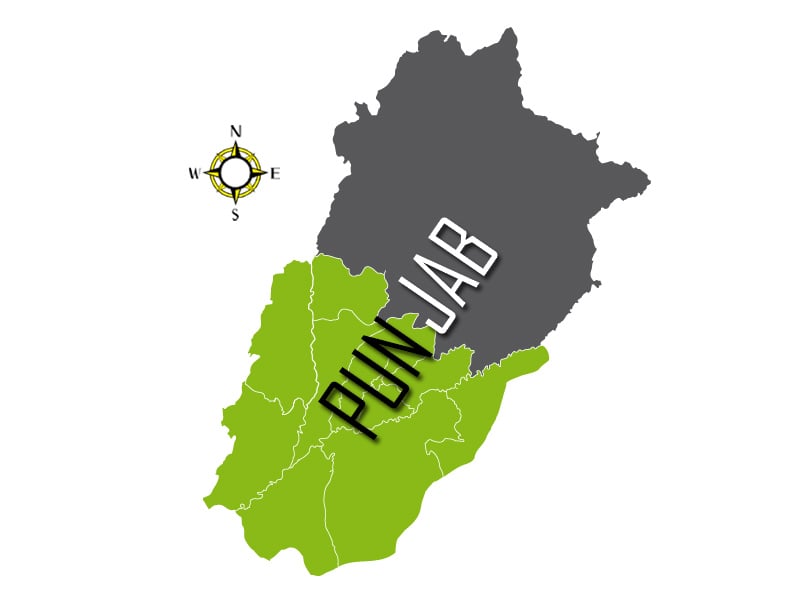
“My party offers unconditional support to the government on the issue of creation of South Punjab and Bahawalpur provinces if legislation is done as per the resolution passed by the Punjab Assembly,” stated PML-N Secretary-General Ahsan Iqbal, while addressing a press conference in Multan.
With the resumption of fresh activities for the creation of the province of South Punjab, the debate for the formation of new provinces in Pakistan will get an impetus. Will old provinces meet an age-old demand to reconsider the provincial map or will it open a Pandora’s box? The centripetal forces resist the formation of new provinces as they want a strong Centre and argue that any change in the existing provincial set-up will promote ethnic nationalism which will undermine the ideology of Pakistan and pave the way for the country’s disintegration.
During its election campaign, the PTI pledged that if it forms government, South Punjab will get a provincial status. Now after 18 months in power, the PTI government asserts that it is transforming this election manifesto into a reality. It is ironic that 73 years after Pakistan’s creation, the country has four provinces whereas Gilgit-Baltistan (G-B) and Azad Jammu and Kashmir (AJK), because of the unsettled issue of Jammu and Kashmir, have not been given a provincial status. At the time of Partition, India had 14 states and seven union territories. Now India has 29 states and nine union territories. Afghanistan currently has 34 provinces and the government wants to create five more whereas Iran has 31 provinces.
The debate of creating new provinces in Pakistan is not new but fails to reach any logical conclusion because those who demand this lack determination and skills to confront those who want to maintain the status quo as far as the provincial map of the country is concerned. Furthermore, the division of Punjab, by carving out a new province consisting of Siraiki-speaking areas, will not be easy because Bahawalpur has an age-old demand that it should be given a provincial status as it does not want to be part of South Punjab. There are demands in Khyber-Pakhtunkhwa (K-P) to establish the Hazara province comprising the Hindko-speaking population. Balochistan faces the issue of the Pashtun ethnic group seeking a separate provincial status. The most dangerous situation will be in Sindh because Sindhi nationalists have made it clear that they will never allow the division of their province. Like South Punjab, the demand for southern Sindh, which would comprise the Urdu-speaking areas of Karachi and Hyderabad, is also a part of the debate for new provinces.
Ahsan Iqbal made it clear that “the matter is not limited to the creation of South Punjab province, but there is a demand of a province from Hazara, Potohar, Kohat, Sindh and Balochistan and if the PTI is sincere then a debate should be held in the Assembly and all the political parties should find a solution to it.” He further stated, “A year ago, the PML-N tabled a bill in the National Assembly for the creation of these provinces and offered the government support. Even today, we extend our unconditional support if it is done according to the resolution passed by the Punjab Assembly. If the government brings in any legislation contrary to the resolution, it means it is playing a game and deceiving people.”
The dynamics of new provinces in Pakistan needs to be analysed from three perspectives. First, historically, because of the abolishment of provinces in the western wing of Pakistan in 1956 and naming the whole as West Pakistan under One Unit, while securing parity with East Pakistan. In 1970, One Unit was abolished and provinces were restored because of the consistent demand made by Sindh, Balochistan and the NWFP. After the disintegration of Pakistan and the emergence of Bangladesh in 1971, the 1973 Constitution followed the federal mode of governance but provinces remained subservient to the Centre. It was the 18th Amendment passed in 2010 which made provinces autonomous in financial and administrative matters. Centrifugal forces that wanted strong provinces argued that Pakistan’s survival as a viable state depended on vibrant provinces.
A counternarrative of the 18th Amendment argued that the financial autonomy of provinces led to enormous financial losses for the Centre because of the huge transfer of funds under the National Finance Commission (NFC) Award. But reversing the amendment will be an uphill task. Second, political schism on lingual and ethnic basis particularly in Sindh may become a major challenge to keep the temperature low as far as major ethnic communities are concerned. To a large extent, the slogan of South Punjab, southern Sindh and Hazara are political in nature and are primarily used during the election campaign. At the time of 2013 and 2018 general elections, the PPP, the PTI and the PML-N used the slogan of new provinces for political consumption without following up on the demands. Now the PTI, which got a huge electoral mandate from southern Punjab, feels embarrassed as opponents accuse it of not practically implementing its manifesto.
The threat of political and ethnic polarisation getting a new impetus following South Punjab’s creation cannot be ruled out. One can expect rising tension between Bahawalpur and Multan, the possible seat of South Punjab, and between Punjabi-speaking people settled in southern Punjab. Nationalistic feelings may also get a boost in Hazara, Bolochistan and Sindh.
Third, there may be economic implications if new provinces are created. Already, the federal government claims to be short of resources because of 18th Amendment policies. Have those demanding and those opposing the creation of new provinces calculated the financial implications of this act? There is nothing wrong if new provinces are established provided people benefit.
Financial implications should not obstruct the formation of new provinces provided resources are rationally allocated and justly used. Presently, there is asymmetry in the provincial set-up of Pakistan as Punjab holds more than 55% of the population and gets the bulk of resources. People in the Siraiki belt and Bahawalpur resent the bureaucracy and political elite of central Punjab for using the resources merely for the development of Lahore. The issue is the lack of political will on the part of parliamentarians belonging to southern Punjab to establish the provinces of South Punjab and Bahawalpur.
Constitutionally, the resolution to create a new province must be passed with a two-thirds majority of the assembly of that province which was done under the PML-N government. Furthermore, the National Assembly should pass that resolution with a two-thirds majority to give that province a legal status. It seems the PTI government is only interested in creating the province of South Punjab and not Bahawalpur, which will contradict the resolution passed by the Punjab Assembly. It is now up to the PTI, the PML-N and the PPP as to how they proceed with this challenge.
Published in The Express Tribune, March 20th, 2020.
Like Opinion & Editorial on Facebook, follow @ETOpEd on Twitter to receive all updates on all our daily pieces.

1728386780-0/BeFunky-collage-(38)1728386780-0-165x106.webp)


1721987069-0/diddy-tupac-(1)1721987069-0-165x106.webp)








COMMENTS
Comments are moderated and generally will be posted if they are on-topic and not abusive.
For more information, please see our Comments FAQ